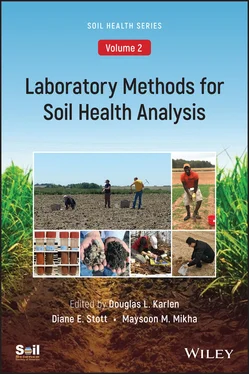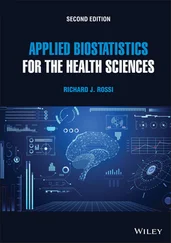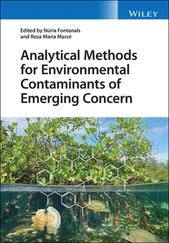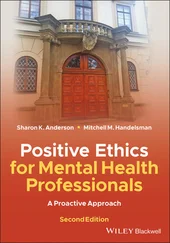Laboratory Methods for Soil Health Analysis, Volume 2
Здесь есть возможность читать онлайн «Laboratory Methods for Soil Health Analysis, Volume 2» — ознакомительный отрывок электронной книги совершенно бесплатно, а после прочтения отрывка купить полную версию. В некоторых случаях можно слушать аудио, скачать через торрент в формате fb2 и присутствует краткое содержание. Жанр: unrecognised, на английском языке. Описание произведения, (предисловие) а так же отзывы посетителей доступны на портале библиотеки ЛибКат.
- Название:Laboratory Methods for Soil Health Analysis, Volume 2
- Автор:
- Жанр:
- Год:неизвестен
- ISBN:нет данных
- Рейтинг книги:3 / 5. Голосов: 1
-
Избранное:Добавить в избранное
- Отзывы:
-
Ваша оценка:
- 60
- 1
- 2
- 3
- 4
- 5
Laboratory Methods for Soil Health Analysis, Volume 2: краткое содержание, описание и аннотация
Предлагаем к чтению аннотацию, описание, краткое содержание или предисловие (зависит от того, что написал сам автор книги «Laboratory Methods for Soil Health Analysis, Volume 2»). Если вы не нашли необходимую информацию о книге — напишите в комментариях, мы постараемся отыскать её.
Analyzing, comparing, and understanding soil health data Soil Health, Volume Two: Laboratory Methods for Soil Health Analysis
Laboratory Methods for Soil Health Analysis, Volume 2 — читать онлайн ознакомительный отрывок
Ниже представлен текст книги, разбитый по страницам. Система сохранения места последней прочитанной страницы, позволяет с удобством читать онлайн бесплатно книгу «Laboratory Methods for Soil Health Analysis, Volume 2», без необходимости каждый раз заново искать на чём Вы остановились. Поставьте закладку, и сможете в любой момент перейти на страницу, на которой закончили чтение.
Интервал:
Закладка:
5 Doran, J.W., and Parkin, T.B. (1994). Defining and assessing soil quality. In: J.W. Doran, D.C. Coleman, D.F. Bezdicek, and B.A. Stewart, editors, Defining soil quality for a sustainable environment. SSSA Special Publication No. 35. Madison, WI: SSSA. p. 3–21. doi:10.2136/sssaspecpub35
6 Doran, J.W., and Jones, A.J. (eds.). (1996). Methods for assessing soil quality. Soil Science Society of America (SSSA) Special Publication No. 49. Madison, WI: SSSA Inc.
7 Hartemink, A. E. and Anderson, S.H. (2020). 100 years of soil science society in the U.S. CSA News 65(6), 26–27. doi:10.1002/csann.20144
8 Hillel, D. (1991). Out of the earth: Civilization and the life of the soil. Oakland, CA: University of California Press.
1 Laboratory Methods for Soil Health Assessment: An Overview
Steven R. Shafer, Douglas L. Karlen, Paul W. Tracy, Cristine L.S. Morgan, and C. Wayne Honeycutt
The purpose for Volume II is to provide specific methods and guidelines available for individuals and laboratories to evaluate soil health indicators discussed in Volume I. This volume draws on and updates the 1996 Soil Science Society of America Special Publication Number 49 entitled Methods for Assessing Soil Quality that is commonly referred to as the “Green Book” for soil quality and soil health assessment. This volume, however, is not merely a revision of the 1996 book, but rather adds guidelines for several new soil health assessment tests and discusses advances in data interpretation made during the past two decades.
Soil health is defined widely as the continued capacity of a soil to function as a vital living ecosystem that sustains plants, animals, and humans (e.g., NRCS, 2020). In recent years, the concept of soil health has become better understood and more widely accepted in the United States and around the world. An important driver for increased interest and global acceptance of the concept is public recognition that to meet food, feed, fiber, and fuel demands associated with an increasing population, soil degradation through erosion and loss of soil organic carbon (SOC) must be stopped and reversed by enhancing desirable biological, chemical, and physical properties and processes within this living, dynamic resource. Thus, over the past 25 years, soil health has become a focal point for serious attention across a range of public‐ and private‐sector agricultural, environmental, and conservation organizations. Collectively, these groups have identified numerous benefits to farmers; the agricultural industry as a whole; water, air and other natural resources; educators; and the general public. This includes identifying and implementing soil health‐promoting practices (e.g., cover crops, reduced intensity and frequency of tillage, improvements in and expanded use of perennials, site‐specific soil and crop management) that can increase SOC (Ismail et al., 1994; Karlen et al., 1994; Ussiri and Lal, 2009; Varvel and Wilhelm, 2010; Wander et al., 1998), thereby increasing available water holding capacity, enhancing drought resistance and resilience (Emerson, 1995; Hudson, 1994; Olness and Archer, 2005), reducing wind and water erosion, and reducing nutrient loss to surface waters (Langdale et al., 1985; Tonitto et al., 2006; Yoo et al., 1988; Zhu et al., 1989). Additional benefits associated with improvements in soil health include increased suppression of pests and pathogens, increased crop yield and quality, improved return on investment, and many broad, nonpoint environmental benefits. Agricultural productivity, economic return, and environmental goals all benefit from enhancing soil health.
The literature on soil health, including the implementation of practices and technologies that promote it, has exploded in recent decades. In a search of literature covered by Google Scholar, Brevik (2018) identified more than 20,000 references using the term “soil health” from January 2000 through February 2018. This represented more than 93% of the total number of references recovered. However, our understanding of soil health and its benefits did not develop over just the past 20 years; indeed, the idea of promoting good soil health is more than 100 years old and has a surprising history. Brevik writes, “The earliest clear reference to soil health found in this review was made by Wallace (1910), who wrote about the importance of humus, particularly as obtained from manure, in maintaining soil health”. The author of this 1910 reference (a thesis submitted to Iowa State University) was a student who eventually would become President Franklin Roosevelt’s Secretary of Agriculture, then Roosevelt’s vice‐president. The name of this earliest known user of the term “soil health” will be familiar to many, as it remains before us today on the largest research station operated by the U.S. Department of Agriculture: the Henry A. Wallace Agricultural Research Center in Beltsville, MD. Thus, the concept of soil health has a particularly illustrious pedigree in the history of agricultural science.
Research on soil properties– physical, chemical, and biological– has led to major advances in managing agricultural soils, contributing to significant crop yield increases throughout the 20th and 21st centuries. However, consensus on a holistic approach to understand, implement, and measure outcomes of soil management, with goals that include sustaining production and enhancing soil health, has escaped the scientific community. Reasons for this include: (i) ever‐changing methods of measurement and how to interpret the data, especially for biological properties and processes; (ii) how to adapt analytical methods for soils having different properties, which may alter results and make data comparisons difficult; (iii) the meaning of analytical results for different agricultural production systems and environments; (iv) unclear links among measurements, soil processes, and desired outcomes (ecosystem services such as agricultural yield, nutrient cycling, improved water quality, etc.); (v) complexity and costs for advanced measurement techniques; (vi) differences in sample handling and measurement protocols among analytical laboratories; (vii) producers’ uncertainties about what the data mean and how to adjust management practices in response to the information, including potential risks and benefits; and (viii) inconsistent messaging about soil health and how to manage it to agricultural producers, natural resources managers, educators, policymakers, and other stakeholders.
Stakeholder diversity alone presents significant challenges to the community of scientists, practitioners, producers, and others who advocate making soil health the cornerstone of agricultural and environmental decision making. The needs of different segments of the community demand different kinds of data, information (interpretation of the data), and communication techniques. For example, the interests of a typical agricultural producer are unlikely to be met with a report on 20 to 30 laboratory measurements that quantify a range of physical, chemical, and biological properties of a soil. Such a report may be more than most producers would want to interpret. On the other hand, a small group of indicators, easily obtained and explained, might be helpful to a producer but insufficiently accurate, precise, and process‐oriented for scientific research. The distinctly different needs of various stakeholders provide a critical starting point for any conversation about soil health.
How Can a Farmer Assess Soil Health in the Field?
Many producers are keen to learn about soil health on their farms and how they can alter their current soil and crop management practices to sustain or improve it. This interest has greatly increased opportunities for agricultural experts who can successfully bridge researcher and producer communities and is a key factor driving development of public and private programs that strive to strive for clear communication about soil health. For example, pasture and range scientists affiliated with the Noble Research Institute in Ardmore, OK, often advise farmers to consider five indicators (Jeff Goodwin, personal communication, 2018), which we summarize here as “the Five C’s of Soil Health”. They are:
Читать дальшеИнтервал:
Закладка:
Похожие книги на «Laboratory Methods for Soil Health Analysis, Volume 2»
Представляем Вашему вниманию похожие книги на «Laboratory Methods for Soil Health Analysis, Volume 2» списком для выбора. Мы отобрали схожую по названию и смыслу литературу в надежде предоставить читателям больше вариантов отыскать новые, интересные, ещё непрочитанные произведения.
Обсуждение, отзывы о книге «Laboratory Methods for Soil Health Analysis, Volume 2» и просто собственные мнения читателей. Оставьте ваши комментарии, напишите, что Вы думаете о произведении, его смысле или главных героях. Укажите что конкретно понравилось, а что нет, и почему Вы так считаете.












